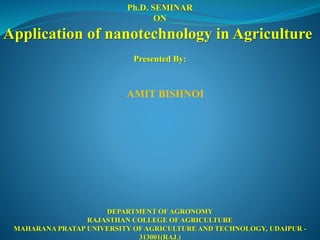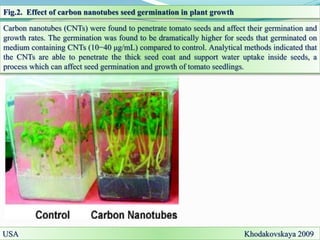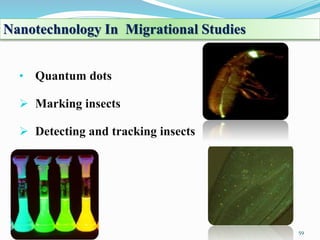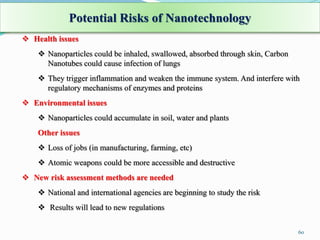Application of nanotechnology in agriculture
- 3. Ph.D. SEMINAR ON Application of nanotechnology in Agriculture Presented By: AMIT BISHNOI DEPARTMENT OF AGRONOMY RAJASTHAN COLLEGE OF AGRICULTURE MAHARANA PRATAP UNIVERSITY OF AGRICULTURE AND TECHNOLOGY, UDAIPUR - 313001(RAJ.)
- 4. Seminar Outline Introduction Background of Nanotechnology Nanoparticles Applications of nanotechnology Nanotechnology in Agriculture and allied sciences Environmental remediation Nanopesticides Conclusion 4
- 5. Introduction Agriculture is the backbone of most developing countries, with more than 60% of the population reliant on it for their livelihood. Agricultural scientists are facing a wide spectrum of challenges such as stagnation in crop yields, low nutrient use efficiency, declining soil organic matter, multi-nutrient deficiencies, climate change, shrinking arable land and water availability and shortage of labour besides exodus of people from farming. we need to attain a sustainable growth in agriculture at the rate of 4% to meet the food security challenges. Nanotechnology is emerging as the sixth revolutionary technology in the current era after the Industrial Revolution of Mid 1700s, Nuclear Energy Revolution of the 1940s, The Green Revolution of 1960s, Information Technology Revolution of 1980s and Biotechnology Revolution of the 1990s. The recent statistics suggest that about 90% of the nano-based patents and products have come from just seven countries, namely, China, Germany, France, Japan, Switzerland, South Korea and USA
- 6. 6 Nanotechnology ?... “Nanotechnology is the art and science of manipulating matter at nanoscale” The design, characterization, production and application of structure, device and system by controlling shape and size at nanoscale British standard institution, 2005
- 7. ‘Nano’- Greek word means ‘Dwarf’ 1 nm = one billionth (10ˉ⁹) of metre Size range between 0.1 and 100 nm 7
- 8. 8
- 9. “There’s Plenty of Room at the Bottom” - at American Physical Society meeting at the California Institute of Technology on Dec-29, 1959. “Adaptability to manipulate, control, assemble, produce and manufacture things at atomic precision” 9 Father of nanotechnology Nobel Laureate-1965 Richard Feynman, Physicist
- 10. Norio Taniguchi, Professor - coined the term “Nanotechnology” (1974) “Nano-technology’’ - Processing, separation, consolidation and deformation of materials by one atom or by one molecule. 10
- 11. ~ 2000 Years Ago Sulfide nanocrystals used by Greeks and Romans to dye hairs ~ 1000 Years Ago Gold nanoparticles of different sizes used to produce different colors in stained glass windows 1959 “There is plenty of room at the bottom” by R. Feynman 1974 Taniguchi uses the term nanotechnology for the first time 1981 IBM develops Scanning Tunneling Microscope 1985 “Buckyball” - Scientists at Rice University and University of Sussex discover C60 1986 • “Engines of Creation” - First book on nanotechnology by K. Eric Drexler. • Atomic Force Microscope invented by Binnig, Quate and Gerbe 1989 IBM logo made with individual atoms 1991 Carbon nanotube discovered by S. Iijima 1999 “Nanomedicine” – 1st nanomedicine book by R. Freitas 2000 “National Nanotechnology Initiative” launched (British Standards Institution, 2005) Time Line of Nanotechnology 11
- 12. 12
- 13. Arranged or assembled into ordered layers, or mine layers Revolutionize agriculture including fertilizer, herbicides ,insecticides management as well as develop new high yielding or resistant verities in the near future Possess distinct physical, biological and chemical properties associated with their atomic strength Bhattacharyya et al., 2010 13 Nanoparticles
- 14. 10nm 50nm Property Below about 100 nm the rules that govern the behaviour of the elements of our known world start to give way to the rules of quantum mechanics, and everything changes Quantum effects 14 Properties of nanoparticles
- 15. Carbon in the form of graphite (i.e. pencil lead) is soft, at the nano-scale, can be stronger than steel and is six times lighter Nano-scale copper is a highly elastic metal at room temperature, stretching to 50 times its original length without breaking Shiny orange yellow Gold changes its colour to brownish black on reducing the size 15 Things behave differently in nano-world
- 16. Scanning Tunneling Microscope or Scanning probe Microscope Gerd Binnig and Heinrich Rohrer in 1981 and get Noble Prize in Physics in 1986 Development of Nanotechnology
- 17. (Royal Society and Royal Academy of Engineering, 2004) METHODS OF NANOPARTICLE PRODUCTION 17
- 18. (Royal Society and Royal Academy of Engineering, 2004) TOP DOWN APPROACH 18
- 19. (Royal Society and Royal Academy of Engineering, 2004)19 BOTTOM UPAPPORAOCH
- 20. Dendrimers Quantumdots Nanosensors FullerenesCarbon Nanotubes Nano Chips C60 Cadmium selinade Tools of Nanotechnology
- 23. Medicine Cancer treatment Bone treatment Drug delivery Appetite control Drug development Medical tools Diagnostic tests Imaging Information Technology Smaller, faster, more energy efficient and powerful computing and other IT-based systems Energy More efficient and cost effective technologies for enenergy production Solar cells Fuel cells Batteries Consumer Goods Foods and beverages Advanced packaging materials, sensors, and lab-on-chips for food quality testing Appliances and textiles Stain proof, water proof and wrinkle free textiles Household and cosmetics scratch free products, paints, and better cosmetics
- 24. Nanomaterials and Agriculture There has been significant interest in using nanotechnology in agriculture The goals fall into several categories Increase production rates and yield Increase efficiency of resource utilization Minimize waste production Nano-based treatment of agricultural waste Nanosensors Specific applications include: Nano-fertilizers, Nano-pesticides
- 25. Application of nanotechnology in agriculture and allied sciences Food technology Crop improvement Seed technology Precision farming Nano-fertilizer for balance crop nutrition Plant disease diaganose Weed management Water management Biosensors (Electronic nose) Agricultural engineering issue Animal science Fishery and aquaculture Pest management 25
- 26. Food science and technology • Nanotechnology for enhancing food security in India Sastry et al., 2011 • Hybrid polymer : Smart packaging with Nano silicon embedded durethan polymer to enhance the shelf life of the food materials Bayer polymers 26
- 27. Precision farming Smart Field System Bio-Nanotechnology has designed sensors which give increased sensitivity and earlier response to environmental changes and linked into GPS These monitor soil conditions and crop growth over vast areas Such sensors have already been employed in US and Australia 27
- 28. Plant pathology 100% growth inhibition was seen in the Pythium ultimum, Magnaporthe grisea, Colletotrichum gloeosporioides, Botrytis cinere and, Rhyzoctonia solani, showed at 10 ppm of the nanosized silica-silver Park et al., 2006 QDs have emerged as pivotal tool for detection of a particular biological marker with extreme accuracy Madhuri et al., 2010 28
- 29. Crop improvement • Gene therapy for plants : use of 3-nm mesoporous silica nanoparticle (MSN) for smuggling foreign DNA into cells. Peterson et al.,2014 • Shown the feasibility of DNA sequencing using a fluidic nanochannel functionalized with a graphene nanoribbon Kyu min et al., 2013 Seed technology • Use of carbon Nanotubes increases the germination through better penetration of the moisture Khodokovskaya et al.,2010 29
- 30. Nanotechnology in Seed Science Detecting pollen load that will cause contamination to ensure genetic purity Use of nano-sensore specific to contaminating pollen can help alert the possible contamination Detection of seed borne pathogens Nano-coating of seeds to improve germination Natarajan and Sivasubramnian, 2007
- 31. Gene transformation in plants is normally carried out by Agrobacterium species, application of some chemicals and physical techniques (electroporation, microprojectile, etc.). Now a days with better efficacy and reproducibility, novel technologies for the direct gene transfer like liposome, positively charged liposome (lipofectin) and nanoparticle based delivery systems are used for genetic transformation of plants. In this review, we have enlightened the novel nanotechnologies like liposome, Carbon nano-tube and nanoparticles with their current status and future prospects in transgenic plant development. Mehrnaz et al., 2012 Fig. 1. Nanotechnology based gene carrier studied in plant biotechnology
- 32. Carbon nanotubes (CNTs) were found to penetrate tomato seeds and affect their germination and growth rates. The germination was found to be dramatically higher for seeds that germinated on medium containing CNTs (10−40 μg/mL) compared to control. Analytical methods indicated that the CNTs are able to penetrate the thick seed coat and support water uptake inside seeds, a process which can affect seed germination and growth of tomato seedlings. USA Khodakovskaya 2009 Fig.2. Effect of carbon nanotubes seed germination in plant growth
- 33. Crop nutrition Management Slow release of nano-fertilizer On situ diagnosis of nutrient status Diagnosis of Nutrient disorder in plants
- 34. Fig.3. Nitrogen use efficiency (%) of conventional and nano-fertilizer TNAU, Coimbtore Subramanian and Tarafdar, 2011
- 35. Fig.4. A) Higher root growth of peanut plant after nanoscale ZnO treatment (1000 ppm). The plants were uprooted after 110 days. B) Pot culture experiment showing higher plant growth after nanoscale ZnO treatment (1000 ppm), after 110 days. Tirupati Parasad et al., 2012
- 36. Tirupati Parasad et al., 2012 Fig. 5. Photograph showing the effect of foliar application of lower dosage of nanoscale ZnO on the pod yield. A and B) nanoscale ZnO @ 2 g/ 15 L and C) control
- 37. Nano-fertilizer technology Use of nanoscale nutrients to suppress crop disease. Amendment protocols necessary to maximize plant health often vary with the level of infection or absence of the pathogen. Micronutrients are critical in the defense against crop disease, with tissue infection inducing a cascade of reactions commonly resulting in the production of inhibitory secondary metabolites. Foliar application of nano Phosphorous as fertilizer (640 mg ha-1) and soil application of phosphorous fertilizer (80 kg ha-1 ) yielded equally in clusterbean and pearl millet under arid environment. Tarafdar et al., 2012
- 38. These metabolites are often generated by enzymes that require activation by micronutrient cofactors. The use of nanoparticle-based micronutrient formulations may offer(Singh, 2012) a highly effective novel platform for crop disease suppression yield enhancement through more targeted strategic nutrition-based promotion of host resistance.
- 39. Nano particles may enter plant leaves through stomata and the cuticle structures. NP metals/metal oxides are more effectively translocated than corresponding bulk elements and that this greater transportability exists in both xylem and phloem. Sufficient micronutrient content in key tissues will enhance plant defense in the presence of pathogens but a number of factors may limit this supply.
- 40. Table 1. Response of peanut to application of nanoscale zinc oxide Tirupati Parasad et al., 2012
- 41. Nano-herbicide for effective weed control Encapsulated herbicide in a MnO2 core shell Smart delivery mechanism TNAU, Coimbatore Chinnamuthu and Kokiladevi, 2007
- 42. Herbicides inside nano particles are developed that can be timed-release or have release linked to an environmental trigger . Less herbicide is required to achieve the reduction weed reduction effects . If the active ingredient is combined with a smart delivery system, herbicide will be applied only when necessary according to the conditions present in the field. (Gruère et al., 2011)
- 43. Fig. 6. Smart delivery of nanoencapsulated herbicide in the crop-weed environment TNAU, Coimbatore Chinnamuthu and Kokiladevi, 2007
- 44. Nano-pesticide Developing pesticides encapsulated in nanoparticles. (OECD and Allianz, 2008) These pesticides may be time released or released upon the occurrence of an environmental trigger (temperature, humidity, light).
- 45. Zahir et al., 201245 Efficacy of plant-mediated synthesized silver nanoparticles against Sitophilus oryzae
- 46. Silver nano particle synthesis by Bt Silver nano particle were synthesised by the spore complex of B. thuriengiensis These nanostructures are highly toxic to multi drug resistant human pathogenic bacteria 46 Jain et al., 2010
- 47. Antifungal activity of NP Cu2O on Phytothphora infestans with tomato. The foliar application resulted in significantly greater protection (73.5 %) from the pathogen, compared to the bulk amendment (57.8 %).(Servin et al., 2015)
- 48. Soil remediation • Nanotech-based soil binder called SoilSet employed to avoid soil erosion Sequoia Pacific Research of Utah (USA) Removal of heavy metals • Ligand based nanocoating can be utilized for effective removal of heavy metals as these have high absorption tendency Water treatments • magnetite (iron oxide) nanocrystals to capture and remove arsenic from contaminated water. Researchers at Rice University 48
- 49. Animal science Nano micelles, liposomes, nano-emulsions complexes improves the utilization efficiency of nutrients in the fodder Fishery and aquaculture NanoCheck- 40 nm lanthanum-based compound absorbs phosphates from the water and prevents algae Growth. Fast growing fish: Younger carp exhibited 30% faster growth rate when fed with iron nanoparticles Russian Academy of Sciences Agricultural Engineering Issues Nano coating of agricultural tools to increase their resistance against wear and corrosion 49
- 50. Application in sericulture 25 ppm of Silver nanoparticles can be used as growth stimulant to increase the silk yield Prabhu et al., 2011 Production of Electrospun silk fibroin based fibers using CNT Seth et al., 2007 50
- 51. Positive effects of Nano materials in crop protection
- 52. Nano – encapsulated agrochemicals designed in such a way that they possess all indispensable properties such as effective concentration with high solubility, stability and effectiveness, time controlled release in response to certain stimuli enhanced targeted activity less Eco toxicity with harmless effortless mode of delivery thus avoiding repetitive application.
- 53. Nano particles on biological systems and the environment such as toxicity generated by free radicals leading to lipid peroxidation and DNA damage. High concentration of nanosilica silver produced some chemical injuries on the tested plants (cucumber leaves and pansy flowers). Negative effects of nano materials
- 54. Environmental remediation Detecting contaminants in food or environmental media by using nano-sensor Amine et al., 2006 Detection of multiple residues of organophosphorus pesticides has been accomplished using a Nanomagnetic particle in an enzyme-linked immunosorbent assay (ELISA) test (Hu et al., 2010) Removal of metal ion and heavy metals from aqueous solutions by using nano-magnets
- 55. Agro chemicals • Agricultural chemical companies such as Monsanto, Syngenta and BASF; have ventured in developing nanoparticle pesticides • The world's leading chemical company already sells a number of pesticide emulsions containing nanoparticles • The positive side of nanoparticle pesticides is that far less need to be applied and reducing cost and environmental damage. 55
- 56. • World’s largest agrochemical company syngenta have number of chemicals with emulsions that contain nanoparticles. To date, none of these agrochemicals are currently labeled as containing nano particles. Syngenta have obtained a patent for ‘GUTBUSTER’ microcapsule will break open in alkaline environments, including the stomach of certain insects (ETC Group, 2004). Syngenta’s US Patent No. 6,544,540 56
- 58. e-Nose Operates like human nose Identify different types of odors and their concentrations Use of ZnO nanoparticles 58
- 59. • Quantum dots Marking insects Detecting and tracking insects 59 Nanotechnology In Migrational Studies
- 60. Potential Risks of Nanotechnology Health issues Nanoparticles could be inhaled, swallowed, absorbed through skin, Carbon Nanotubes could cause infection of lungs They trigger inflammation and weaken the immune system. And interfere with regulatory mechanisms of enzymes and proteins Environmental issues Nanoparticles could accumulate in soil, water and plants Other issues Loss of jobs (in manufacturing, farming, etc) Atomic weapons could be more accessible and destructive New risk assessment methods are needed National and international agencies are beginning to study the risk Results will lead to new regulations 60
- 62. National Science and Technology Council (USA) claims that: “Nanotechnology is an enabling technology that will change the nature of almost every human-made object in the next century.” Future of Nanotechnology This statement has obvious meaning that Nanotechnology is capable of changing the way almost everything is designed and made: from computers to clothing; from sports equipments to space ships and satellites; from cars to cancer therapies; from bridges to paint; and even objects and devices not yet imagined.
- 63. From the ongoing presentation, it can be concluded that the Nanotechnology is capable of being used in agricultural products that protect plants and monitor plant growth and detect diseases Scientists are still seeking new applications of nanotechnology in agriculture and the food industry The agricultural sector and the food industry will indeed see tremendous changes for the better in the coming years 63 Conclusion
- 64. 64 Nano
Editor's Notes
- Nanoscience and technology are today at the same stage as information technology was in 1960s and biotechnology was in the1980s.
- For example, Si-accumulating species are known to show resistance to a number of foliar and
- controlled release of agrochemicals and site targeted delivery of various macromolecules needed for improved plant disease resistance, efficient nutrient utilization and enhanced plant growth.
- ‘Primo MAXX-plant growth regulator’ ‘ Banner MAXX Fungicide’ ‘Apron MAXX RFC seed treatment’ ‘Cruise MAXX Beans” ‘Primo MAXX-plant growth regulator’ ‘ Banner MAXX Fungicide’ ‘Apron MAXX RFC seed treatment’ ‘Cruise MAXX Beans”
- In this slide, you can see how Nanotechnology could help redesigning the future of several technologies, products and markets. Scientists and engineers can now work with materials at the atomic level to create stain-proof fabrics, more efficient fuel cells and batteries…
































































